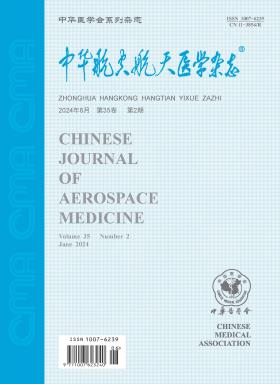Effect of simulated hypoxic exposure on cerebral blood perfusion of pilots
引用次数: 0
Abstract
Objective To provide physiological basis of cerebral function identification of pilots in hypoxic environment by observing the pilots' cerebral blood perfusion characteristics before and after hypoxic exposure. Methods Thirty-five healthy male pilots were subjected to normal and hypoxic exposure that the oxygen concentration was 14.5%. We inspected the cerebral blood perfusion by arterial spin labeling technology and compared the differences between the two states. Results After hypoxic exposure, the pulse was (63.97±10.43) beats/min (t=4.969, P<0.01), it was lower than before which was (71.46±10.63) beats/min. The oxygen saturation was (92.46±3.64)%, it was lower than before which was (96.31±1.23)% (t=6.437, P<0.01). Arterial spin labeling (ASL) in pilots after hypoxic exposure showed lower cerebral blood flow (CBF) values prominently in the following regions: the bilateral superior temporal gyrus, the bilateral middle temporal gyrus, the left inferior temporal gyrus, the right middle occipital gyrus, the right inferior occipital gyrus, the bilateral lingual gyrus, the right fusiform gyrus, the right cuneus and cerebellum (P<0.05). Conclusions The cerebral blood perfusion after hypoxic exposure is decreased mainly in the temporal and occipital lobe for the right side, and arterial spin-labeling technique can monitor CBF changes of the pilots in hypoxic exposure. Key words: Magnetic resonance imaging; Anoxia; Cerebrovascular circulation; Pulsatile flow; Hemoperfusion; Pilots模拟缺氧暴露对飞行员脑血流灌注的影响
目的通过观察飞行员缺氧前后脑血流灌注特征,为低氧环境下飞行员脑功能鉴定提供生理依据。方法对35名健康男性飞行员进行氧浓度为14.5%的正常和低氧暴露。采用动脉自旋标记技术检测脑血流灌注,比较两种状态的差异。结果缺氧暴露后脉搏为(63.97±10.43)次/min (t=4.969, P<0.01),低于缺氧前的(71.46±10.63)次/min。血氧饱和度为(92.46±3.64)%,低于治疗前的(96.31±1.23)% (t=6.437, P<0.01)。低氧暴露后飞行员的动脉自旋标记(ASL)显示双侧颞上回、双侧颞中回、左侧颞下回、右侧枕中回、右侧枕下回、双侧舌回、右侧梭状回、右侧楔叶和小脑的脑血流(CBF)值明显降低(P<0.05)。结论低氧暴露后脑血流灌注减少主要发生在右侧颞叶和枕叶,动脉自旋标记技术可监测飞行员低氧暴露后脑血流变化。关键词:磁共振成像;缺氧;脑血管循环;跳动的流;血液灌流;飞行员
本文章由计算机程序翻译,如有差异,请以英文原文为准。
求助全文
约1分钟内获得全文
求助全文
来源期刊

中华航空航天医学杂志
航空航天医学
自引率
0.00%
发文量
2962
期刊介绍:
The aim of Chinese Journal of Aerospace Medicine is to combine theory and practice, improve and popularize, actively advocate a hundred flowers bloom and a hundred schools of thought contend, advocate seeking truth from facts, promote the development of the related disciplines of aerospace medicine and human efficiency, and promote the exchange and penetration of aerospace medicine and human efficiency with other biomedical and engineering specialties.
Topics of interest for Chinese Journal of Aerospace Medicine include:
-The content of the journal belongs to the discipline of special medicine and military medicine, with the characteristics of multidisciplinary synthesis and cross-penetration, and mainly reflected in the aerospace industry, aerospace flight safety and efficiency, as well as the synthesis of special medicine, preventive medicine, environmental medicine, psychology, etc.
-Military aeromedicine (Air Force, Navy and Army aeromedicine) and civil aeromedicine, with a balance of aerospace medicine are the strengths of the journal.
-The change in aerospace medicine from a focus on promoting physiological compensatory adaptations to enhancing human performance under extreme environmental conditions is what the journal is helping to promote.
-The expansion of manuscripts in high altitude medicine is also a special emphasis of the journal.
 求助内容:
求助内容: 应助结果提醒方式:
应助结果提醒方式:


